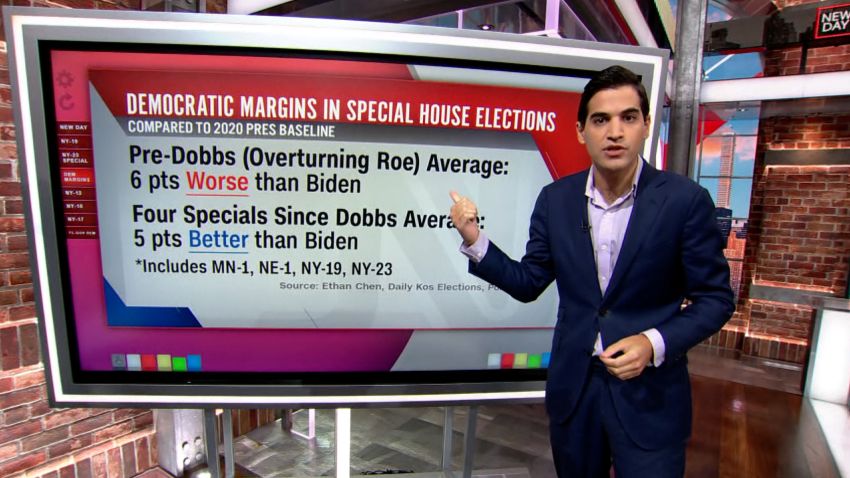A special election, on its own, cannot tell us much about the political environment. Grouped together, special elections can tell a story.
And in the case of special elections for the US House since Roe v. Wade was overturned, the story is clear: The national environment has become far more favorable to Democrats over the past two months.
Prior to the US Supreme Court ruling that there was no longer a federal constitutional right to an abortion, Republicans were doing quite well in special House elections. They were outperforming the 2020 presidential baseline by an average of 6 points. This had been a very good sign for the party ahead of the 2022 midterm elections.
Since the high court decision, there have been four special House elections. The results share one thing in common: Democrats did better than Joe Biden in all of them.
Democrat Pat Ryan’s margin of victory in the special election for New York’s 19th Congressional District stands at a little over 2 points as of Wednesday afternoon. That’s better than Biden’s 1.5-point margin in the district in 2020. Ryan won by focusing his campaign on his support for abortion rights.
Although the 19th District race received most of the press, there was also a special election Tuesday for another upstate New York seat that tells the same Democratic overperformance story. Joe Sempolinski held the 23rd District for Republicans by a margin of about 6.5 points, as of Wednesday afternoon – President Donald Trump carried the seat by a little over 11 points in 2020.
These two special House elections followed ones in Minnesota and Nebraska where Republicans won but underperformed Trump’s 2020 margin by 6 points.
All told, Democrats are averaging a 4-point overperformance in House specials since Roe was overturned. This is a 10-point shift from where they were on average before the ruling.
I should note that the turnout for these special elections was not particularly high. Things could look different before a much larger midterm electorate – especially elections in more diverse places. (The recent specials have all been in districts that are Whiter than average.)
Other indicators
That said, these elections aren’t the only signs of something happening.

Kansas hosted perhaps the most pivotal primary day of the last few months, with its ballot measure that would have taken away the state constitutional right to an abortion. The August turnout in the Sunflower State looked a lot more like that of a midterm general election.
The result wasn’t just that Kansas voters overwhelmingly rejected the anti-abortion ballot measure but that Democrats saw their highest turnout relative to 2018 of any primary so far this year.
Moreover, these special elections and primaries were happening in different parts of the country. Some were in the Midwest, and others were in the Northeast.
Nor are the specials the only signal that there’s been a dramatic change in the national environment. We see it in the polling too.
Take a look at the generic congressional ballot, which usually asks respondents some form of the following question: “If the elections for Congress were held today, would you vote for the Democratic or Republican party?”
Republicans had an average 3-point advantage on the question during the late spring and early summer. Today, that lead has evaporated. The two parties are tied on the generic ballot.
So what does all of this mean for the fall election?
The changing tide is probably not enough for Democrats to hold on to the House. Republicans need a net pickup of only four seats. The generic ballot has historically trended toward the opposition party from this point until the fall election. It can have a bit of a bias against the GOP too (e.g., in 2014, when Republicans were basically neck and neck with Democrats on the generic ballot late in the campaign but then easily won the House popular vote).
Additionally, polling still shows that Republicans are more certain to vote in the fall than Democrats. This is backed up by the fact that more people have been voting in GOP primaries than Democratic primaries, relative to 2018, even since Roe was overturned.
That said, the idea of a red wave, as many including myself were hinting at earlier in the cycle, looks far less likely at the moment.
This changing environment could be enough for Democrats to hold on to the Senate, where Republicans have the additional problem of nominees in pivotal states who are not well liked by the voters.
Whatever ultimately happens, it’s clear that, at least today, we are in a far different place politically than we were two months ago.



